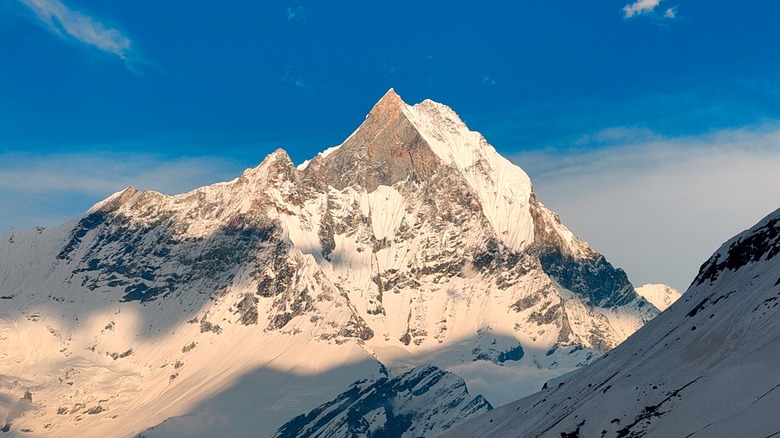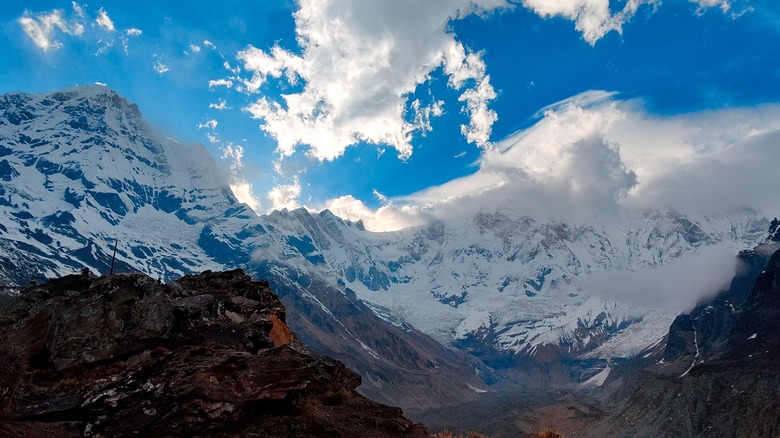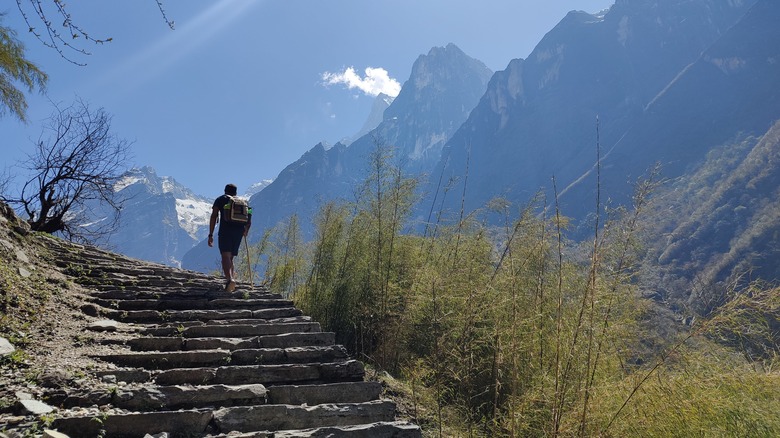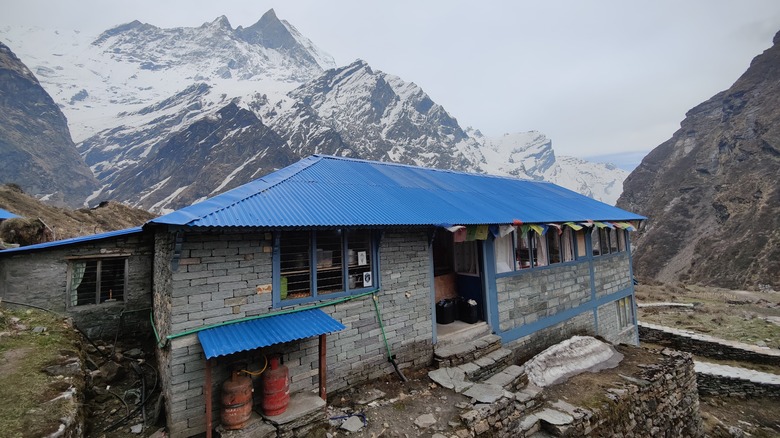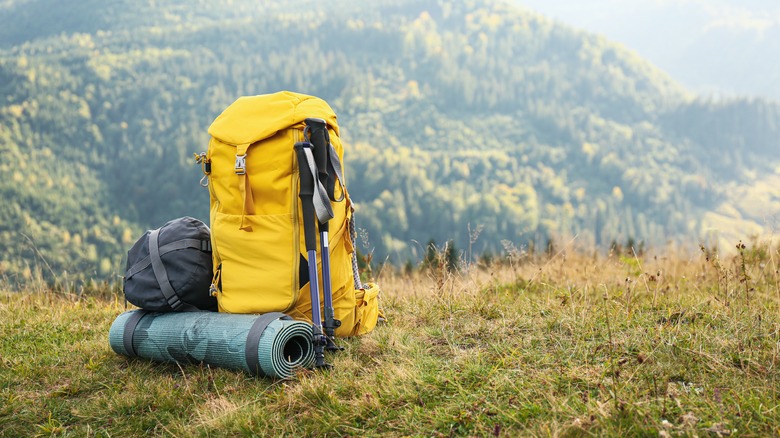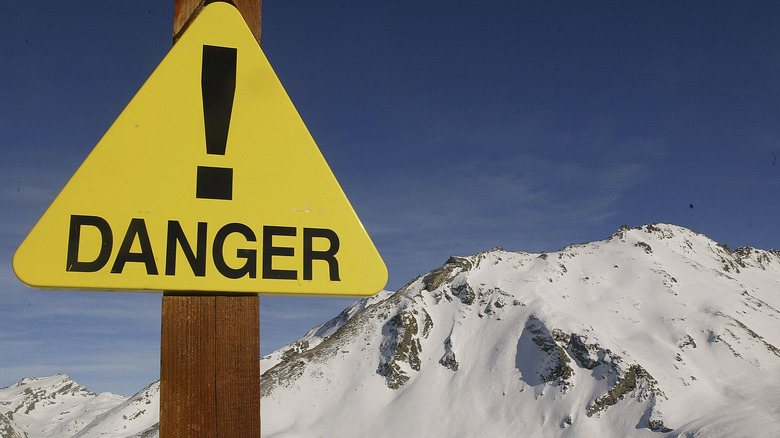Why Nepal's Annapurna Base Camp Trek Is A Must-Do For Adventure Seekers
Nepal, the country that is home to eight of the world's 14 tallest mountains, is the place to go if you love trekking. Located in the midst of the towering Himalayas, Nepal contains an endless number of multi-day hikes that deliver breathtaking 360-degree mountain views — and, in this trekker's paradise, one of the most popular thru hikes is Annapurna base camp. This trek to the base camp of the world's tenth tallest mountain (Annapurna I) definitely delivers on the views and is the perfect option for adventure seekers who are up for a challenge.
The Annapurna base camp trek (ABC) is a six to eight day in-and-out trek that starts at Sauli Bazaar at an elevation of 3,773 feet and ascends to Annapurna base camp which is at an elevation of 13,550 feet and is where mountaineers start their journeys to the summit of Annapurna I. The ABC trek takes you through the Annapurna Conservation Area where you will cross extension bridges and climb terraced hills up to alpine valleys filled with rocky trails and prayer flags. I completed the ABC trek in 2023 and absolutely loved my experience. So, here is some of my advice for why and how you should hike ABC.
What you will see on the Annapurna base camp trek
There's a reason that so many people who visit Nepal choose the Annapurna base camp trek, and one of them is the variety of incredible landscapes and sights you will see along the trail. The first day of trekking to ABC takes you through traditional Nepali villages where you can watch as animals graze in the fields, locals go about their daily work, and trains of pack mules loaded down with goods pass you by.
By the second day, you will get stunning views of Machhapuchhre, also called Fishtail Mountain because its twin peaks look like the two-pronged tail of a fish diving into the sea. By the fifth day, you will reach Machhapuchhre base camp (MBC) — where mountaineers would start their journey to the summit of Fishtail Mountain if they were allowed to climb it (no one is allowed on the summit because it is believed to be the home of Lord Shiva).
After MBC, the next stop is Annapurna base camp where you can stand on loose gray rocks on the edge of an enormous gorge staring across at Annapurna I, Annapurna III, and Annapurna South with Fishtail at your back. If you choose to stay the night at Annapurna base camp, you can also wake up before dawn to capture the sun rising over the wall of these snow-capped mountains that together make up the Annapurna Range.
Trek difficulty and route options
Another reason that the Annapurna base camp trek is one of Nepal's most popular is because it is a great option for first-time visitors. However, this is not because the trek is not difficult — ABC requires some physical preparation and has multiple six-to-nine-hour days that consist of just stairs — but rather because it is relatively low in elevation. Yes, even though ABC's highest point is 13,550 feet, it is lower than the ultra-high Everest base camp trek or the grueling Manaslu circuit trek making it a better option for hikers who are new to high-altitude trekking.
Another reason that ABC is good for first-time visitors is because the trail is full of small villages. This means that if you find the trek too challenging, you can easily break up the longer days into smaller, more manageable days by stopping more often than scheduled. You can also add more stops if you simply want extra time to take in the view. I chose to add two days to my trek to spend the night in both Machhapuchhre base camp and Annapurna base camp in order to fully enjoy being completely surrounded by towering peaks. Also, if you are willing to make your trek a little longer, you can add a two-day detour to Poon Hill where you will be treated to views of not only Annapurna I and Annapurna South but also Dhaulagiri (the world's seventh-tallest mountain).
What to know before you go
To trek in Nepal, you are required to book a tour through an approved trekking company. These companies will help you plan your trekking itinerary, acquire the necessary permits, book stays at guesthouses, and organize transportation to and from the trailhead. The company will also provide you with a local guide. You are not required to hire porters, although it is typically recommended.
I suffer from hiker's knee pain and can tell you that my experience would have been much different (worse) if it hadn't been for the help of my porter. Porters and guides in Nepal work for tips and often expect one at the end of the journey. In my experience, guides and porters feel uncomfortable telling you how much money they believe is an appropriate tip; however, after much prodding, I've learned that porters are normally tipped around $5 a day while guides usually get around $10 a day.
Nepal generally has two trekking seasons. The busiest season is in fall (October and November). This is the time of year when the weather is cool and mild and the skies are completely clear and bright blue — making for incredible photos. The other option is to visit in the spring (February through April) when there is a higher chance of rain but you get to see blooming rhododendrons and experience less-crowded trails.
Recommended gear
Like many other treks in Nepal, ABC is a teahouse trek which means that you will be staying in basic guesthouses every night and won't have to carry your own tent, food, or cooking supplies. These teahouses also have electricity, WIFI, and hot showers (although they will likely charge an extra fee for using those services). Most also offer warm blankets, although many people prefer to bring their own sleeping bags. Three meals and a few hot drinks are also typically included in your stay, but you may still want to bring snacks for the trail (if possible, try to avoid bringing beef as Nepal is a Hindu nation).
For the trek, you will need moisture-wicking clothing along with a good pair of hiking shoes. Because the trail is quite steep in places and made of uneven stone steps, trekking poles are also recommended. At such a high elevation, Annapurna base camp is typically quite cold (below freezing) and you will need warm layers like a fleece, down jacket, thick socks, a hat, and gloves while there. If you plan your trek in spring, you should also bring a rain poncho and umbrella.
Lastly, although free water is available all along the trail from various spigots, this water has not been sanitized. Therefore, you will need to have your own water purification system whether that is through a filter or purification tablets.
Safety tips
Although you won't ascend as high as you would during some of Nepal's other treks, the ABC trek still comes with a risk of altitude sickness. Because of this, it is very important to ascend slowly and make sure to take rest days or move to lower altitudes whenever you experience telltale signs of altitude sickness like a worsening headache or nausea. Also, make sure that you avoid alcohol, drink lots of water, and eat a carb-heavy diet while on the trail. For serious cases of altitude sickness, you will need to be picked up by rescue helicopter and taken to lower altitudes as quickly as possible.
Another risk on the ABC trek is avalanches, which are most likely to happen in spring and winter when the mountains have heavy snow cover. Along the trail, you will notice signs that warn you are in an avalanche risk zone and your guide will likely tell you not to linger in that area. Small avalanches are much more common than large ones; however, large avalanches have occurred in the region with the last serious one taking place in 2020.
